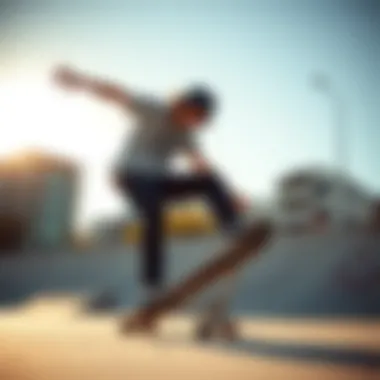Exploring Deathwish 8.25: Skateboard Performance Insights


Intro
The world of skateboarding is a vibrant tapestry woven from the threads of passion, style, and creativity. Among the many brands that have made their mark, Deathwish Skateboards holds a place of distinction, particularly with its 8.25 skateboard model. This article aims to peel back the layers of the 8.25, diving into its design, functionality, and the pivotal role it plays within the broader skate culture.
For both novice skaters and seasoned pros, the Deathwish 8.25 serves as more than just a deck; it’s a vehicle for self-expression and a tool for mastering the art of skating. Whether you’re hitting the streets or cruising at a park, every detail of the board, from its dimensions to its graphics, resonates with a purpose.
The article is structured to guide you through an exploration of techniques and tricks suited to various skill levels, essential gear for any skateboarder, and the current trends shaping the industry. Each section reflects a snapshot of what makes the 8.25 significant in today’s skateboarding scene.
By the end of this journey, skateboarders, hobbyists, parents, and retailers will gain a more profound insight into the skater’s experience, unlocking the nuances of how gear impacts performance. As we delve deeper, let’s first explore the techniques and tricks that define the skating experience.
Prologue to Deathwish Skateboards
Skateboarding has evolved over the decades into a vibrant culture, melding artistry, athleticism, and community spirit. Within this landscape, Deathwish Skateboards holds a significant place, known for pushing the limits of both design and functionality. The introduction of the Deathwish 8.25 skateboard model further exemplifies the brand's commitment to enhancing rider performance while fostering a sense of identity among skateboarders. This model, with its precise measurements and thoughtful construction, is not just a board; it’s a tool that bridges the gap between technical prowess and personal expression.
Historical Context of Deathwish
Established in the midst of a dynamic skateboarding scene, Deathwish Skateboards emerged as a reaction to the mainstream, with a focus on authenticity and raw talent. Founded in 2008 by renowned skaters James Brockman and Baker Skateboards, the brand quickly garnered attention for its unapologetic approach towards skateboarding culture.
The brand's narrative is deeply rooted in the idea of rebellion, shaped by skateboarders who thrive on overcoming challenges. Deathwish is not merely a name; it's a declaration that foreshadows the exhilarating, at times perilous, journey of a skater. The cultural insignia that the brand represents resonates strongly with skaters who value not just the sport but the community it creates.
The Deathwish Brand Philosophy
Deathwish Skateboards embodies a philosophy that transcends the technical specifications of its skateboards. At its core, the brand stands for individuality and resilience. Skateboarding is as much about personal style and creativity as it is about tricks and performance. Deathwish combines these elements by designing boards that not only meet the demands of today’s advanced tricks but also celebrate the various artistic expressions of skaters worldwide.
- Authenticity: Deathwish values true passion over gimmicks, aiming to resonate with skaters who are genuine in their pursuit of the sport.
- Community: Beyond the product, the brand fosters a sense of belonging, encouraging skateboarders to connect and share their experiences.
- Performance: The engineering behind each board, particularly the 8.25 model, reflects the brand's dedication to performance, allowing skaters to perform at their best.
Through its commitment to these principles, Deathwish not only caters to a diverse range of skateboarding styles and skill levels but also stimulates discussions about what skateboarding can be within the broader cultural context. Skateboarders, hobbyists, and anyone invested in the evolution of skate culture will find that understanding Deathwish Skateboards is fundamental to appreciating the intricate dance between gear and performance.
Understanding Skateboard Measurements
Understanding skateboard measurements is a fundamental aspect of selecting the right board for a skater's performance and style. It may seem trivial to the untrained eye, yet a board's specifications can significantly influence the way a rider experiences skating. When discussing measurements, key elements like width, length, and concavity come into play, each contributing to the overall handling, stability, and versatility of the skateboard. By grasping these details, riders can make informed decisions that enhance their performance and enjoyment.
Significance of Skateboard Width
Skateboard width plays a pivotal role in how a board feels beneath a skater’s feet. An ideal width allows for better balancing, control, and comfort, especially during tricks or high-speed rides. Typically, the width of a standard skateboard ranges from 7.5 inches to 8.5 inches, with the Deathwish 8.25 falling comfortably in the middle. This measurement is favored by various riders because it strikes a balance between stability and maneuverability. Wider boards, such as the Deathwish 8.25, offer greater landing surface for tricks, making it a go-to option for skaters who often engage in flip tricks and grinds.
Moreover, skateboard width also caters to individual riding styles. Street skaters may prefer narrower setups for better flick and pop, while vert riders might favor wider boards due to their enhanced grip and stability. The Deathwish 8.25 provides versatility, allowing it to adapt to both street and park skating.
"Choosing the right skateboard width is like selecting the right pair of shoes—comfort and performance go hand in hand."
Implications of the 8. Measurement
The 8.25 measurement is significant in several realms—practical, technical, and cultural. From a practical standpoint, this width is often seen as a sweet spot. It enables skaters to execute a variety of tricks while retaining a measure of control. For example, riders can tackle technical flip tricks with confidence, thanks to the ample space for foot placement that the 8.25 offers.
On a technical level, a wider board can perform differently based on the materials and design features. The Deathwish 8.25 often boasts a sturdier construction, contributing to its durability and responsiveness. The combination of its width with a well-considered concavity facilitates quicker edge transitions, supporting the rider during more complex moves.
Culturally speaking, the 8.25 width has carved out a niche in the skate community. As skateboarding develops and many skaters explore their creativity, the versatility of the 8.25 boards becomes apparent in various skate genres—be it street, park, or vert. The Deathwish brand, with its aggressive branding and attitude, resonates with a demographic that seeks not just performance but also an identity that aligns with their passion for skating.


Design Features of the Deathwish 8.
When it comes to skateboards, design is more than just aesthetics; it's about functionality and performance. The Deathwish 8.25 skateboard showcases a thoughtful combination of structural elements and visual appeal. Understanding these features is crucial for riders looking to maximize their skating experience. Let's break down the design elements, starting with material selection and moving onto the skateboard's shape.
Material Composition
Types of Wood Used
The Deathwish 8.25 is primarily constructed using a blend of hard maple wood, which is revered in the skateboard world for its weight-to-strength ratio. This type of wood is well-known for providing excellent shock absorption, allowing for smoother rides over various terrains. In addition, the selection of maple supports a snappy pop, essential for performing tricks and stunts.
Moreover, Deathwish uses a unique lamination process, incorporating multiple layers of wood, which enhances the overall sturdiness of the skateboard while maintaining a lightweight profile. This attribute is especially sought after by street skaters who require a board that can handle the grind yet remains agile enough for flick tricks.
The distinctive feature of hard maple is not just in its flexibility but also in its resistance to warping. Unlike some softer woods, maple holds its shape better over time, making it a reliable choice for long-term use. However, it does come with a slight downside: wood maintenance should not be overlooked, as external moisture can compromise its integrity over extended periods.
Durability and Performance
Durability is a cornerstone of the Deathwish 8.25's appeal. The skateboard is designed to withstand the rigors of daily skating. The construction method, alongside the quality of the materials used, significantly influences both durability and performance.
The board is built to endure high-impact tricks without delaminating or losing shape. This characteristic is particularly advantageous for skateboarding enthusiasts who regularly engage in heavy landings from ollies or flips. Moreover, riders often notice a satisfactory responsiveness when performing tricks, attributed to the board’s robust layer structure.
One unique aspect of the Deathwish 8.25 is its anti-chip technology. This feature protects the edges of the skateboard from wear and tear, which can be a scourge for many boards. But while that offers a longer lifespan, it's important to be mindful that more durable boards tend to come at a marginally higher price.
Shape and Concavity
Tail and Nose Design
The tail and nose of the Deathwish 8.25 are designed with a moderate concave shape, providing riders with an excellent grip during tricks. The slight curve not only aids in board control but also in initiating flips and spins. With a tailored design, it caters to both street and park skateboarding.
The tail is beefier than many competitors, allowing for greater leverage when popping off the ground. This design is a favorite amongst tricksters since it offers added security during jumps. However, some might argue that a bulkier tail could negatively influence maneuverability for more technical tricks.
Another interesting feature is the wider nose. The broad surface gives skaters the benefit of stability, which can be moot when transitioning between tricks and balancing.
Impact on Trick Performance
When it comes to the Deathwish 8.25, performance in tricks can dramatically improve due to its shape. The unique combination of added tail height and the overall width of the board plays a crucial role in enhancing trick execution. Riders find that they can quickly master new moves thanks to the board's responsiveness.
This responsiveness encourages skaters to experiment more confidently with complex tricks, knowing they have a sturdy platform beneath them. Importantly, a well-structured tail lends itself to greater pop and lift when attempting aerial tricks. However, it's worth noting that if a rider is more accustomed to a flatter board, adjusting to this newly designed tail may take some time.
Performance Attributes of the Deathwish 8.
When it comes to skateboarding, the phrase "the right board can make all the difference" rings particularly true. The performance attributes of the Deathwish 8.25 skateboard illustrate just how pivotal specific elements can be in shaping a rider's experience. From stability to the ability to execute various tricks, the design and craftsmanship of this board cater to diverse riding styles, enhancing both control and versatility. Dive in as we unpack what makes the performance of the Deathwish 8.25 stand out.
Stability and Control
Stability and control are two crucial pillars of performance in skateboarding. The Deathwish 8.25 has been meticulously designed to provide a steady ride, even for skaters who push their limits. Its 8.25-inch width strikes a balance that encourages confidence, particularly when landing tricks or navigating through challenging terrain.
One aspect that plays a significant role in stability is the board's low center of gravity. Riders often note that this feature allows them to feel planted on the deck, making it easier to execute tricks without fear of wobbling or losing balance.


"With the Deathwish 8.25, I feel like I can push harder and still stick my landings. It's just stable enough to give me the confidence to try new things," remarks one seasoned rider.
This board's ability to maintain control doesn't just benefit experienced skaters; beginners also find it reassuring. Having a board that offers stability instills a sense of safety, enabling new riders to learn without the anxiety of excessive wobbling.
In conjunction with stability, the concave design of the Deathwish 8.25 provides a snug fit for the feet. This aspect is essential for controlled maneuvers and tricks, as skaters can effectively lock their feet in place, improving overall performance. Whether someone is cruising down the street or launching off a jump, that level of control can’t be overlooked.
Versatility for Various Tricks
Another compelling attribute of the Deathwish 8.25 is its versatility, which opens up a world of tricks for riders at any skill level. Its generous dimensions and well-thought-out design afford skaters the flexibility to experiment with a range of styles, from street skating to ramps and everything in between.
The wider stance allows for easier maneuvering, making it feasible to tackle trick variations such as flip tricks, grinds, and slides. Riders frequently mention the adaptability of the board, stating it supports their creativity and exploration in skating. For instance, a skater wanting to master a kickflip will find that the board’s responsiveness helps them get the right flick, while someone experimenting with grinds can take advantage of its spaciousness for greater foot placement.
Moreover, this board performs exceptionally well in transitioning environments. Whether going from a flat surface to a park with ramps or obstacles, the Deathwish 8.25 ensures that the skater remains engaged with the terrain. This fosters an intuitive riding experience where riders can react to the environment effortlessly.
In summary, the performance attributes of the Deathwish 8.25—its stability, control, and versatility—make it a commendable choice for many. Skateboarders appreciate how a well-crafted board can enhance their skills and expand their horizons. With a design tailored to the complexities of skating, the Deathwish 8.25 proves itself as an essential tool for both aspiring and seasoned skaters alike.
For a closer look at related discussions and experiences about skateboards, check out the community forums at reddit.com or browse articles on britannica.com for more insights.
User Demographics and Experiences
Understanding who opts for the Deathwish 8.25 skateboard is vital for multiple reasons. First, it helps in recognizing the skateboard's appeal across different segments of riders, each bringing unique needs and preferences. This insight sheds light on how the 8.25 model accommodates varied riding styles, providing a blend of stability and versatility suitable for both enthusiasts and newcomers.
The demographics of skateboard users can vary widely, influenced by factors such as age, skill level, and riding environment. Typically, the 8.25 width attracts an audience ranging from seasoned skaters who favor technical tricks to novices looking for a balance between performance and ease of use. This model finds fans among both individuals who are entering the scene and those who have soaked up the streets for years.
Who Chooses the 8.?
The individuals gravitating towards the 8.25 skateboard specifically include:
- Intermediate to Advanced Riders: They are usually seeking better control during intricate tricks, making the 8.25 ideal due to its width and sturdy build.
- Street Skaters: Urban environments often demand a skateboard that can handle various surfaces and obstacles, and the Deathwish 8.25 steps up to meet these challenges.
- Transition Skaters: Those who enjoy skate parks and ramps find that the width affords them stability when navigating transitions and performing aerial maneuvers.
- Casual Enthusiasts: This group often consists of younger skaters or beginners who appreciate the board's reliability when learning to ride. Its forgiving nature helps many master the fundamental skills of skateboarding.
Rider Testimonials and Reviews
Rider experiences provide a rich tapestry of insights into how the Deathwish 8.25 performs in the real world. Testimonials often reveal how the skateboard holds up under various conditions, reflecting the subjective nature of skateboarding and personal preference.
For example, some users have praised the board's balance when executing tricks, saying it feels like an extension of their movement. "It's like the board just knows what I want to do, and it responds perfectly," a rider might say when reflecting on their experience at a skater-owned cafe.
Others have noted its durability as a crucial factor, remarking on how the 8.25 withstands the wear and tear of street use. Riders will often share their experiences through forums like Reddit or dedicated skater communities, adding layers to the understanding of how product features translate into performance.
In sum, discerning who chooses the Deathwish 8.25 and what they say about it helps paint a clearer picture of its place within the vast landscape of skateboards. Travelers, park dwellers, and urban street riders alike contribute to a growing narrative that shapes skateboard culture, guiding future design improvements and user expectations.
The Role of Deathwish in Skate Culture
Deathwish Skateboards stands as a prominent entity within the world of skateboarding, making significant contributions to its culture and community. Understanding this role is imperative for those who engage with skateboarding in any capacity, whether as casual hobbyists or fervent enthusiasts. Deathwish is not just about skateboards; it’s a lifestyle and a movement that resonates through the ethos of skateboarding itself.
Influence on Trends and Styles
- Shaping the Aesthetic: It's no secret that Deathwish has a unique flair that distinguishes it from the myriad of skateboard brands on the market. With graphics that often challenge conventional design, Deathwish captures the rebellious spirit of skateboarding. The bold imagery and color palettes draw attention and inspire skateboarders to express themselves through their skate gear. This influence permeates through various styles, leading to trends that prioritize individuality over uniformity.
- Innovations in Design: The Deathwish 8.25 has also played a pivotal role in introducing trends in skateboard shaping and sizing. The dimensions of the board, particularly its width and concave, have pushed other brands to reevaluate their designs. The 8.25 width is often seen as that sweet spot, catering to street and park riders alike. As such, skaters observing their peers on Deathwish boards might find themselves gravitating toward these specifications for their boards.
- Cultural Identity Marker: For many skaters, riding a Deathwish board becomes a statement about their identity and affiliation with a particular subculture within skateboarding. The brand's rebellious ethos resonates deeply with riders who often seek to differentiate themselves in a playground that thrives on creativity and uniqueness.


"Riding a Deathwish isn't just about the gear; it's about owning a piece of the culture that celebrates risk, creativity, and the relentless pursuit of style."
Sponsorships and Team Riders
Deathwish's impact extends far beyond product offerings, directly influencing skateboarding through its sponsorship of team riders. The way sponsored athletes are perceived can heavily sway public opinion and brand loyalty.
- Elite Talent Representation: Deathwish has cultivated a reputation for backing some of the most skilled skaters in the game. Riders like Jamie Foy and Jonny Giger aren't just names on a team roster; they embody the brand's spirited approach to skating, often pushing the envelope in terms of performance and style. These sponsored athletes significantly shape how both fans and aspiring skaters view Deathwish.
- Influencing New Generations: The presence of these professional riders means that young, aspiring skateboarders gain a relatable template for success. Seeing their favorite skaters perform gravity-defying tricks on a Deathwish board can tilt their loyalty toward the brand, fostering an organic connection between skaters and the gear they use. Additionally, the online content generated by these riders, from tutorials to lifestyle videos, serves to educate and inspire others in the skate community.
- Community Engagement: Deathwish often engages with local skate communities through events and competitions that showcase their team riders. These gatherings reinforce the brand's credibility, allowing them to connect directly with skaters and ultimately showing that Deathwish is comitted to nurturing the culture rather than just profiting from it.
For enthusiasts, parents, and retailers alike, understanding Deathwish's role in skate culture offers a comprehensive view of how this brand continues to shape not only the preferences of riders but also the very nature of skateboarding itself. The dynamic interaction between trends, styles, and sponsorships creates a vibrant tapestry that enriches the skateboarding experience.
Comparative Analysis with Other Skateboards
In the competitive realm of skateboarding, knowing how one board stacks up against others in the market can significantly influence a rider's choice. The Comparative Analysis with Other Skateboards area helps identify not only the technical specifications of the Deathwish 8.25 but also its advantages and limitations compared to rival brands. Examining this segment uncovers patterns that could lead to better purchasing decisions and greater satisfaction among users. Cost, design, and performance attributes all play roles in shaping the preferences of various riders, from beginners to seasoned pros.
Key Competitors in the Market
To understand where the Deathwish 8.25 stands, it’s essential to take a look at its main competitors in the world of skateboards. These brands include Anti-Hero, Element, and Girl Skateboards.
- Anti-Hero: Known for their resilient and versatile boards, they provide strong competition. Riders often praise their boards for stability during tricks.
- Element: This brand emphasizes eco-friendly materials, appealing to those conscious about their environmental impact. Their boards often boast a wide variety of designs, attracting many in the skate community.
- Girl Skateboards: With a focus on performance and style, Girl has a reputation for creating high-quality decks that balance durability with technical advancements.
By comparing the Deathwish 8.25 with these brands, riders can see a common thread: each skateboard offers unique experiences based on their particular features. Understanding these differences can refine signature styles and meet specific needs in skating preferences.
Distinctive Features of Deathwish 8.
The Deathwish 8.25 is not just another skateboard; it has characteristics that set it apart in a crowded marketplace. Among these distinctive aspects are:
- Width: At 8.25 inches, this board offers a sweet spot for street and park skaters. It provides the right balance between stability and maneuverability.
- Concavity: The depth of the concave shape allows for easier flip tricks and provides a solid foothold. It truly enables riders to maintain control.
- Graphics: Deathwish is infamous for its bold artwork, which resonates with skaters looking to express their individuality.
- Material Quality: Crafted from sturdy maple, the deck is built to endure harsh conditions while offering a responsive feel. The durability factor adds significant value, as it can withstand technical elements while maintaining its shape.
"The right board can make all the difference in performing tricks smoothly. For many, the choice comes down to personal style and board responsiveness."
- Skateboarding Expert*
By focusing on these key features, it’s clear that the Deathwish 8.25 does not only compete but carves its own niche within skateboard offerings. Understanding these aspects contributes to making informed decisions when selecting between the options available in today's market.
The End: The Legacy of Deathwish 8.
The Deathwish 8.25 skateboard epitomizes more than just a plank of wood with wheels; it stands as a symbol of innovation in skateboarding culture. From its inception, this particular dimension of skateboard—8.25 inches—has catered to a wide audience, including both seasoned pros and newcomers alike. Its versatility enables diverse skating styles while ensuring that riders have a solid, stable platform for tricks.
Summary of Findings
Throughout this exploration, several key points about the Deathwish 8.25 come to light:
- Design Sensibility: The blend of durable materials and thoughtful shape positions the 8.25 as a reliable skateboard.
- Performance Benefits: Users experience a heightened sense of control and balance, which is critical for executing complex tricks.
- Cultural Relevance: The board's impact goes beyond the skatepark; it influences trends, fashions, and community values within the broader skateboarding culture.
These aspects combined indicate that the Deathwish 8.25 is not merely about riding; it envelopes values of excitement, expression, and camaraderie among skaters.
Future Prospects for Deathwish
Looking ahead, it is clear that the Deathwish brand will continue its legacy. Potential developments could revolve around improved materials, such as utilizing eco-friendly or advanced composite woods, which can enhance durability without compromising performance.
Additionally, as skateboarding continues to gain global popularity, Deathwish might expand on collaborations with artists, enhancing their visibility and relevance. New partnerships could also align with the shift toward inclusivity in the sport, catering to diverse demographics - particularly the growing number of female skaters and those in less represented regions.
In summary, the Deathwish 8.25 skateboard, with its compelling design and robust cultural significance, is poised to remain a mainstay within the skateboarding community. As it evolves, engaging with both old and new audiences will be crucial, ensuring that it meets the demands of changing trends and preferences while staying true to its roots.



